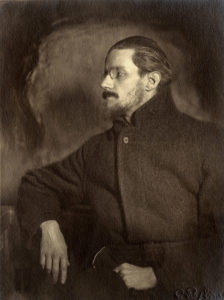
See image credit below.
James Joyce’s “The Dead” is widely considered to be his best short story, called by the New York Times “just about the finest short story in the English language” and by T.S. Eliot as one of the greatest short stories ever written.
The storyline is simple enough: a long-married Irish couple – Gretta and Gabriel Conroy – attend a lavish dinner party thrown by his aunts in celebration of the Feast of the Epiphany (January 6). At the party, they each have a variety of conversations with assorted party guests, and Gabriel gives the evening’s post-dinner speech and leads the toast. As Gabriel and Gretta leave the party, the snow which had been lightly falling when they arrived at the beginning of the evening has become quite heavy.
The closing scene finds Gretta asleep at their hotel while Gabriel stands at the window looking at the snow blanketing the city. Gabriel feels, in fact, that the snow is falling over the entirety of Ireland. Before falling asleep, Gretta had shared a memory about Michael Furey, the Irish activist lover of her youth. The reader is left to wonder whether Gabriel feels sorrow or acceptance over his wife’s confession that she still harbors feelings for her former lover.
The ending, it would seem, is deliberately ambiguous. Indeed, the ending forces the reader to go back into the story looking for clues as to whether we’re supposed to read the ending as “happy” or “sad.”
While “The Dead” is quite a famous story, less well known to the general public is its place as the culminating story in Joyce’s first book, a collection of short stories titled Dubliners. The collection was rejected 17 times over a 10-year period, with some of those rejections being based on what publishers and printers considered to be objectionable material. Finally published in 1914, this collection of 15 stories was Joyce’s first attempt to bring his native city to life. Of course, he would go on to write again and again about the Irish capital, most famously in his 1922 novel, Ulysses, which recounts one day in the life of Leopold Bloom as he makes his way through the streets of Dublin.
But Dubliners was Joyce’s initial portrait of a city he both loved and hated. Each story in the collection features a different resident of Dublin, and each tells a different tale of the suffocating, dreary lives lived in this city. The characters presented here suffer from spiritual paralysis and squelched freedom. Joyce himself admitted that the stories capture some of the unhappiest moments of life. If you’re looking for uplifting literature, Dubliners is not the book for you.
When read against the backdrop of these stories, “The Dead” – which is the finale of sorts to Dubliners – takes on an extra richness, an extra dimension. When read in this context, the story’s ambiguous ending becomes both easier and harder to read. Has Gabriel had an epiphany about the ways in which the dead live on in the memories of the living? Or has he succumbed – as the other characters in the Dubliners stories do – to a kind of paralysis, a numbing inability to be fully alive? Is the snow a beautiful phenomenon that brings all of Ireland together? Or is it a symbol of coldness, of death, a killing frost? As one source says, “In every corner of the country, snow touches both the dead and the living, uniting them in frozen paralysis. However, Gabriel’s thoughts in the final lines of Dubliners suggest that the living might in fact be able to free themselves and live unfettered by deadening routines and the past. Even in January, snow is unusual in Ireland and cannot last forever.”
To consider the ending yourself, you’ll want to read this powerful story, which you can do for free at Project Gutenberg (and in fact, you can read the entire Dubliners collection there as well). If you prefer a hard copy, there’s an inexpensive Dover Thrift Edition.
You might also want to watch John Huston’s 1987 film adaptation of “The Dead.” It starred his daughter Angelica Huston as Gretta Conroy and Donal McCann as her husband, Gabriel.
Want to dig deeper? A helpful glossary of terms is available, and a digitized copy of the first edition of Dubliners can be found at Internet Archive. Richard Ellman’s biography of James Joyce remains the standard, though its revised edition was published more than 30 years ago. Cornell’s James Joyce Collection is outstanding. You might also want to visit The James Joyce Centre – either online or in person in Dublin!
As you await the Feast of the Epiphany and settle in for your own snow viewing this winter, consider the ending lines of “The Dead”:
A few light taps upon the pane made him turn to the window. It had begun to snow again. He watched sleepily the flakes, silver and dark, falling obliquely against the lamplight. The time had come for him to set out on his journey westward. Yes, the newspapers were right: snow was general all over Ireland. It was falling on every part of the dark central plain, on the treeless hills, falling softly upon the Bog of Allen and, farther westward, softly falling into the dark mutinous Shannon waves. It was falling, too, upon every part of the lonely churchyard on the hill where Michael Furey lay buried. It lay thickly drifted on the crooked crosses and headstones, on the spears of the little gate, on the barren thorns. His soul swooned slowly as he heard the snow falling faintly through the universe and faintly falling, like the descent of their last end, upon all the living and the dead.
Podcast: Play in new window | Download
Subscribe to StoryWeb in iTunes.Listen to the podcast in Stitcher.
Now! Listen to StoryWeb on Spotify!
Image Credit: James Joyce in 1918, just four years after the publication of Dubliners. Public domain. https://commons.wikimedia.org/wiki/File:Revolutionary_Joyce_Better_Contrast.jpg.